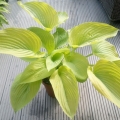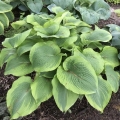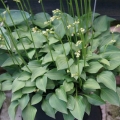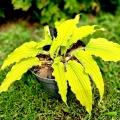Online Shop
130
Royal Horticultural Society
Gold Medals
Royal Horticultural Society
Gold Medals
- Home
- About Bowdens
- Paul Whittaker
- Nature of the Beast by Paul Whittaker - The Guardian 4 November 2006
Nature of the Beast by Paul Whittaker - The Guardian 4 November 2006
Bamboo has a reputation as a monster in the garden, all because a few thugs give the rest a bad name. But buy the right varieties, says Paul Whittaker, and you'll never look back.
Reliable, tolerant and stately are bold statements to make about any subject. Add quick, colourful and easy, and you have a good description of bamboo - more precisely, the hardy bamboos grown in this country. These ancient, woody grasses offer year-round value, being almost entirely evergreen in the UK. Plant them now and, with the right treatment, they will quickly make a gorgeous addition to the garden.
Care
Start with young plants and allow your bamboo to develop. Large specimens are expensive and often sulk for a few years; younger plants play catch-up.
Most bamboos prefer full sun or light shade. Height will differ wildly depending on where you live - wind, for example, is a great pruner.
Bamboos are suited to most soils except dry sand and bog, and they love organic matter. The best food is their own shed leaves and sheaths and, on the whole, they'll look after themselves. Mature plants need old culms (canes) removing, however, along with thinning and pruning of lower branches on some species.
Where to plant
Bamboo makes great screens and boundary hedges, in which case I recommend you mix varieties - much more fun. If you're doing this, select species of equal vigour. You'll have to do some homework, but the heights and growth rates should be on the labels.
Bamboo is also good for giving structure to mixed borders, especially in winter. It can be kept in pots, too, but remember that any container plant passes responsibility to you for its wellbeing. Tall varieties blow over and dry out, so experiment with shorter species such as the many fargesia forms. Larger bamboos can adapt to containers, however the 5m Phyllostachys aurea may only grow to 3m because of the restrictive nature of the pot, and some annual thinning of the culms will prevent it becoming too top heavy. Essential are quality compost, drainage and regular food, specifically slow-release fertiliser, such as Osmocote.
What to choose
The majority of bamboos are self-contained and tidy; the few that do colonise rapidly should either be avoided (generally, this means the sasas, pseudosasas, pleioblastus and the very tall forms of phyllostachys) or controlled regularly by chopping the rhizome with a sharp spade.
There are, broadly speaking, three main types to choose from. The first tend to have thick canes - as opposed to a dense colony of thinner canes - and a tree-like shape with fluttering, leafy heads. They are mostly clump-forming and non-invasive. But do your research: there are some hooligans out there.
Among this group are some of the highly ornamental bamboos that you picture in your mind's eye. Chusquea culeou, for example, is tall, growing to 5m. Phyllostachys aureosulcata f. spectabilis has bright golden culms, grooved green. It's a large, compact specimen up to 6m, with new culms tinted red in sunlight. P. nigra, the black bamboo, is usually compact, with green culms turning jet-black after a year or two.
Some of the well-behaved plants in this category include the compact phyllostachys such as P. aurea and its many cultivars, averaging 4.5m. Semiarundinaria kagamiana and S. yashadake 'Kimmei', with dark green and yellow culms respectively, are shorter at between 2.5m and 4m.
Another broad grouping covers bamboos that tend to have aggressive root systems (though, as always, there are exceptions). They vary in appearance - you'll find shorter, grass-like varieties and taller, tropical-looking ones. This group is best avoided for obvious reasons, but some have their uses. Pleioblastus fortunei variegatus is short and wispy, with white and green streaked leaves. It's good in pots, but is also adept at colonisation so makes useful ground cover.
Some bamboos in this group form dense, marching colonies and will need regular rhizome chopping if you wish to control them. Vertical root barriers of concrete or tough polythene to a 60cm depth are often used, but ultimately the plant will suffer because they impede water and nutrient flow; anyway, the bamboo often escapes over them.
The third type of bamboo forms dense clumps of thin canes and, importantly, these are not invasive. If in doubt, you should go for one of these. They include the fargesia (the most reliable, clump-forming bamboo), thamnocalamus and yushania from western China and the Himalayan foothills. They are ideal as screens, specimen plants and, with careful nurturing, container planting. Fargesia robusta, for example, is tight, tidy and robust to 4m or 5m. F. rufa is short and elegant with pale sea-green foliage billowing from arching culms. It looks spectacular in a pot. Go on, treat yourself.
Reliable, tolerant and stately are bold statements to make about any subject. Add quick, colourful and easy, and you have a good description of bamboo - more precisely, the hardy bamboos grown in this country. These ancient, woody grasses offer year-round value, being almost entirely evergreen in the UK. Plant them now and, with the right treatment, they will quickly make a gorgeous addition to the garden.
Care
Start with young plants and allow your bamboo to develop. Large specimens are expensive and often sulk for a few years; younger plants play catch-up.
Most bamboos prefer full sun or light shade. Height will differ wildly depending on where you live - wind, for example, is a great pruner.
Bamboos are suited to most soils except dry sand and bog, and they love organic matter. The best food is their own shed leaves and sheaths and, on the whole, they'll look after themselves. Mature plants need old culms (canes) removing, however, along with thinning and pruning of lower branches on some species.
Where to plant
Bamboo makes great screens and boundary hedges, in which case I recommend you mix varieties - much more fun. If you're doing this, select species of equal vigour. You'll have to do some homework, but the heights and growth rates should be on the labels.
Bamboo is also good for giving structure to mixed borders, especially in winter. It can be kept in pots, too, but remember that any container plant passes responsibility to you for its wellbeing. Tall varieties blow over and dry out, so experiment with shorter species such as the many fargesia forms. Larger bamboos can adapt to containers, however the 5m Phyllostachys aurea may only grow to 3m because of the restrictive nature of the pot, and some annual thinning of the culms will prevent it becoming too top heavy. Essential are quality compost, drainage and regular food, specifically slow-release fertiliser, such as Osmocote.
What to choose
The majority of bamboos are self-contained and tidy; the few that do colonise rapidly should either be avoided (generally, this means the sasas, pseudosasas, pleioblastus and the very tall forms of phyllostachys) or controlled regularly by chopping the rhizome with a sharp spade.
There are, broadly speaking, three main types to choose from. The first tend to have thick canes - as opposed to a dense colony of thinner canes - and a tree-like shape with fluttering, leafy heads. They are mostly clump-forming and non-invasive. But do your research: there are some hooligans out there.
Among this group are some of the highly ornamental bamboos that you picture in your mind's eye. Chusquea culeou, for example, is tall, growing to 5m. Phyllostachys aureosulcata f. spectabilis has bright golden culms, grooved green. It's a large, compact specimen up to 6m, with new culms tinted red in sunlight. P. nigra, the black bamboo, is usually compact, with green culms turning jet-black after a year or two.
Some of the well-behaved plants in this category include the compact phyllostachys such as P. aurea and its many cultivars, averaging 4.5m. Semiarundinaria kagamiana and S. yashadake 'Kimmei', with dark green and yellow culms respectively, are shorter at between 2.5m and 4m.
Another broad grouping covers bamboos that tend to have aggressive root systems (though, as always, there are exceptions). They vary in appearance - you'll find shorter, grass-like varieties and taller, tropical-looking ones. This group is best avoided for obvious reasons, but some have their uses. Pleioblastus fortunei variegatus is short and wispy, with white and green streaked leaves. It's good in pots, but is also adept at colonisation so makes useful ground cover.
Some bamboos in this group form dense, marching colonies and will need regular rhizome chopping if you wish to control them. Vertical root barriers of concrete or tough polythene to a 60cm depth are often used, but ultimately the plant will suffer because they impede water and nutrient flow; anyway, the bamboo often escapes over them.
The third type of bamboo forms dense clumps of thin canes and, importantly, these are not invasive. If in doubt, you should go for one of these. They include the fargesia (the most reliable, clump-forming bamboo), thamnocalamus and yushania from western China and the Himalayan foothills. They are ideal as screens, specimen plants and, with careful nurturing, container planting. Fargesia robusta, for example, is tight, tidy and robust to 4m or 5m. F. rufa is short and elegant with pale sea-green foliage billowing from arching culms. It looks spectacular in a pot. Go on, treat yourself.
New Additions
-
Wundergold £15.00

-
Unruly Child £14.00

-
Twin Cities £11.00

-
venusta 'Porter' £8.00

-
Valley's Love Birds £10.00





